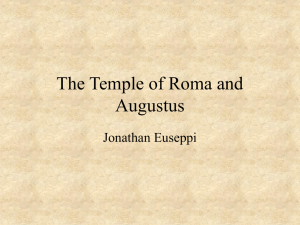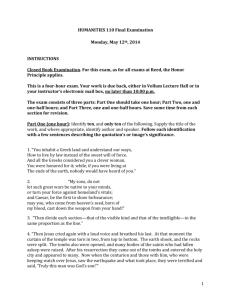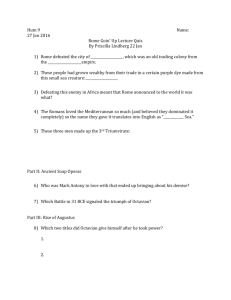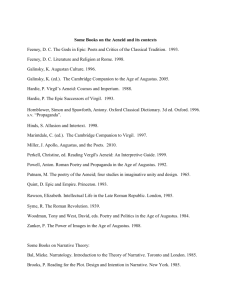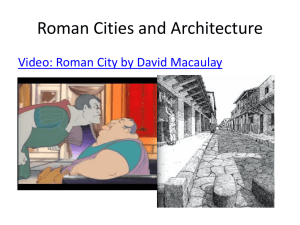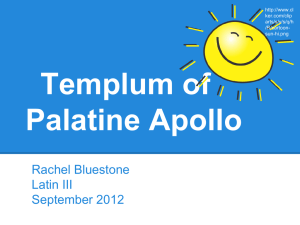Res Gestae Divi Augusti activity
advertisement
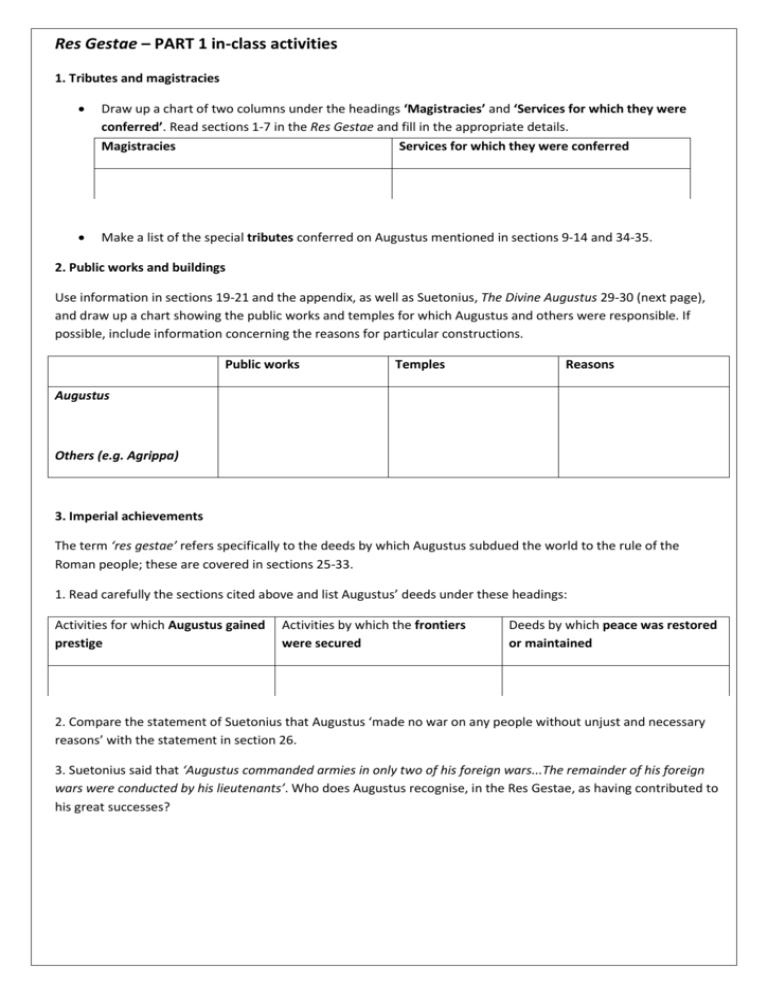
Res Gestae – PART 1 in-class activities 1. Tributes and magistracies Draw up a chart of two columns under the headings ‘Magistracies’ and ‘Services for which they were conferred’. Read sections 1-7 in the Res Gestae and fill in the appropriate details. Magistracies Services for which they were conferred Make a list of the special tributes conferred on Augustus mentioned in sections 9-14 and 34-35. 2. Public works and buildings Use information in sections 19-21 and the appendix, as well as Suetonius, The Divine Augustus 29-30 (next page), and draw up a chart showing the public works and temples for which Augustus and others were responsible. If possible, include information concerning the reasons for particular constructions. Public works Temples Reasons Augustus Others (e.g. Agrippa) 3. Imperial achievements The term ‘res gestae’ refers specifically to the deeds by which Augustus subdued the world to the rule of the Roman people; these are covered in sections 25-33. 1. Read carefully the sections cited above and list Augustus’ deeds under these headings: Activities for which Augustus gained prestige Activities by which the frontiers were secured Deeds by which peace was restored or maintained 2. Compare the statement of Suetonius that Augustus ‘made no war on any people without unjust and necessary reasons’ with the statement in section 26. 3. Suetonius said that ‘Augustus commanded armies in only two of his foreign wars...The remainder of his foreign wars were conducted by his lieutenants’. Who does Augustus recognise, in the Res Gestae, as having contributed to his great successes? Suetonius (c.69-after 122 CE): The Divine Augustus 29 A great number of public buildings were erected by him, the most considerable of which were a forum, containing the temple of Mars the Avenger, the temple of Apollo on the Palatine hill, and the temple of Jupiter Tonans in the Capitol. The reason of his building a new forum was the vast increase in the population, and the number of causes to be tried in the courts, for which, the two already existing not affording sufficient space, it was thought necessary to have a third. It was therefore opened for public use before the temple of Mars was completely finished; and a law was passed that causes should be tried, and judges chosen by lot, in that place. The temple of Mars was built in fulfilment of a vow made during the war of Philippi, undertaken by him to avenge his father's murder. He ordained that the senate should always assemble there when they met to deliberate respecting wars and triumphs; that thence should be despatched all those who were sent into the provinces in the command of armies; and that in it those who returned victorious from the wars should lodge the trophies of their triumphs. He erected the temple of Apollo in that part of his house on the Palatine hill which had been struck with lightning, and which, on that account, the soothsayers declared the God to have chosen. He added porticos to it, with a library of Latin and Greek authors; and when advanced in years, used frequently there to hold senate, and examine the rolls of the judges. He dedicated the temple to Jupiter the Thunderer, in acknowledgment of his escape from a great danger in his Cantabrian expedition; when, as he was travelling in the night, his litter was struck by lightning, which killed the slave who carried a torch before him. He likewise constructed some public buildings in the name of others; for instance, his grandsons, his wife, and sister. Thus he built the portico and basilica of Lucius and Gaius, and the porticos of Livia and Octavia, and the theatre of Marcellus. He also often exhorted other persons of rank to embellish the city by new buildings, or repairing and improving the old, according to their means. In consequence of this recommendation, many were raised; such as the temple of Hercules and the Muses, by Marcius Philippus; a temple of Diana by Lucius Cornificius; the Court of Freedom by Asinius Pollio; a temple of Saturn by Munatius Plancus; a theatre by Cornelius Balbus; an amphitheatre by Statilius Taurus; and several other noble edifices by Marcus Agrippa. 30. He divided the city into regions and districts, ordaining that the annual magistrates should take by lot the charge of the former; and that the latter should be superintended by wardens chosen out of the people of each neighborhood. He appointed a nightly watch to be on their guard against accidents from fire; and to prevent the frequent inundations, he widened and cleansed the bed of the Tiber, which had in the course of years been almost dammed up with rubbish, and the channel narrowed by the ruins of houses. To render the approaches to the city more commodious, he took upon himself the charge of repairing the Flaminian way as far as Ariminum, and distributed the repairs of the other roads amongst several persons who had obtained the honour of a triumph; to be defrayed out of the money arising from the spoils of war. Temples decayed by time, or destroyed by fire, he either repaired or rebuilt; and enriched them, as well as many others, with splendid offerings. On a single occasion, he deposited in the cell of the temple of Jupiter Capitolinus, sixteen thousand pounds of gold, with jewels and pearls to the amount of fifty millions of sesterces. ~ The translation of Alexander Thomson, R. Worthington, New York, 1883 ~ 4. Expenditure The table gives section numbers for Augustus’ personal expenditure. For each of the sections note the following: a. The recipients b. Number of times he distributed largesse (charity/donations/gift) c. Size of the individual donations d. Source of his funds Res Gestae section Money and grain contributions 15; 18 Payments to his veterans 15; 16 Payments for land for his veterans 16 Assistance to state treasury 17 Payment into the military treasury 17 Building/restoration of temples 19; 20 Religious dedications 21 Public works 19; 20; 21 Games and shows 22; 23 Remittances to Italian municipia 21 Gifts to provincial cities 24 Answers Res Gestae Divi Augusti – PART 2 homework “Res Gestae Divi Augusti, (Latin: "The Deeds of the Divine Augustus") is the funerary inscription of the first Roman emperor, Augustus, giving a first-person record of his life and accomplishments. The Res Gestae is especially significant because it gives an insight into the image Augustus portrayed to the Roman people. Various inscriptions of the Res Gestae have been found scattered across the former Roman Empire. The inscription itself is a monument to the establishment of the Julio-Claudian dynasty that was to follow Augustus.” (Wikipedia) Read Bradley pp. 418 – 420 to find out more about the Res Gestae. Then choose TWO parts from ONE of the sections below: 1. 2. 3. 4. Sections 1-14 (honores) Sections 15-25 (impensae) Sections 26-33 (res gestae) Sections 34-35 (exempla virtutis & Pater Patriae) a) Write out the TWO parts in your own words so its meaning is easy to understand and difficult or unfamiliar terms are explained. b) Find out as much as you can about the events Augustus is referring to. Is there anything inaccurate in Augustus’ account? Are there any inconsistencies? Is anything important omitted? c) Based on the parts you’re looking at, should the Res Gestae be described as propaganda*? d) In the next lesson we will briefly share what we have learned. * propaganda: "Propaganda is the deliberate, systematic attempt to shape perceptions, manipulate cognitions, and direct behavior to achieve a response that furthers the desired intent of the propagandist." Garth Jowett and Victoria O'Donnell "Propaganda is neutrally defined as a systematic form of purposeful persuasion that attempts to influence the emotions, attitudes, opinions, and actions of specified target audiences for ideological, political or commercial purposes through the controlled transmission of one-sided messages (which may or may not be factual) via mass and direct media channels.” Richard Alan Nelson
